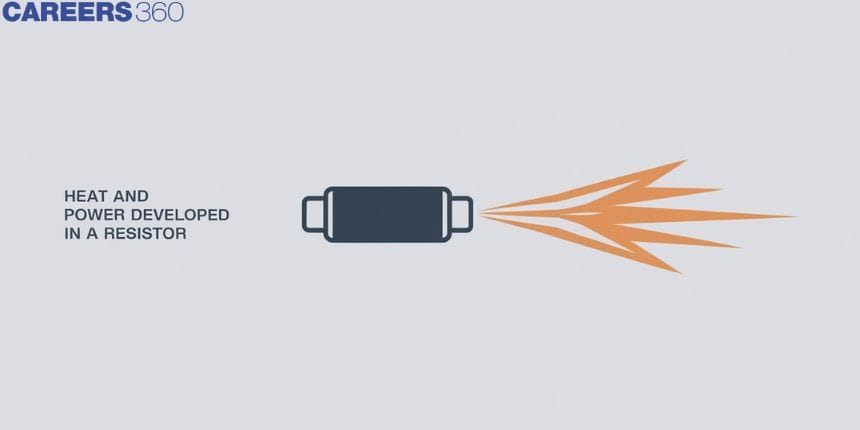Heat And Power Developed In A Resistor
In our daily lives, we frequently encounter electrical devices that rely on resistors to function efficiently. Resistors play a crucial role in controlling the flow of current in circuits, but their importance extends beyond mere regulation. The heat and power developed in a resistor are fundamental concepts in electrical engineering and physics. When an electric current passes through a resistor, it encounters resistance, which converts some of the electrical energy into heat. This phenomenon is not just theoretical; it has practical implications in devices ranging from toasters and electric heaters to the internal components of computers and other electronic gadgets. Understanding how heat and power are generated in resistors helps us design better systems that optimize performance and safety, ensuring that everyday devices operate efficiently and effectively.
This Story also Contains
- Heat and Power Developed in a Resistor
- Solved Examples Based on Heat And Power Developed In A Resistor
- Summary

Heat and Power Developed in a Resistor
When an electric current flows through a resistor, two key phenomena occur heat and power dissipation. The resistor, designed to resist the flow of current, converts electrical energy into thermal energy through the process of Joule heating.
The heat developed in a resistor: When a steady current flows through a resistance R for time t, the loss in electric potential energy appears as increased thermal energy(Heat H) of the resistor and $H=i^2 R t$
The power developed $=\frac{\text { energy }}{\text { time }}=i^2 R=i R=\frac{V^2}{R}$ (from Ohm's law)
The unit of heat is the joule (J)
The unit of power is the watt (W)
Recommended Topic Video
Solved Examples Based on Heat And Power Developed In A Resistor
Example 1: One kg of water, at $20^{\circ} \mathrm{C}$, is heated in an electric kettle whose heating element has a mean (temperature averaged) resistance of $20 \Omega$. The RMS voltage in the mains is 200 V. Ignoring heat loss from the kettle, the time taken (in minutes) for water to evaporate fully, is close to :
[ Specific heat of water = $=4200 \mathrm{~J} /\left(\mathrm{kg}^{\circ} \mathrm{C}\right.$, Latent heat of water = 2260 kJ/kg]
1) 22
2) 16
3) 3
4) 10
Solution:
The heat developed in a resistor
$H=i^2 R t=\frac{V^2}{R} t$
so,
$m s \Delta T+m L=\frac{V^2}{R} t$
$\begin{aligned} & 1 \times 4200 \times\left(100^{\circ}-20^{\circ}\right) c+1 \times 22.6 \times 10^5=\frac{(200)^2}{20} t \\ & 336 \times 10^3+226 \times 10^3=2 \times 10^3 t \\ & t=1298 \text { sec. }=21.6 \mathrm{~min} \approx 22 \text { minutes }\end{aligned}$
Hence, the answer is the option (1).
Example 2: The resistive network shown below is connected to a D.C. source of 16 V. The power consumed by the network is 4 watts. The value of R (in $\Omega$ ) is :

1) 8
2) 16
3) 1
4) 6
Solution:
Heat developed in a resistor
$H=i^2 R t$
So the power developed $=\frac{\text { energy }}{\text { time }}=i^2 R=i R=\frac{V^2}{R}$
i.e for the circuit
$\begin{aligned} & P=\frac{v^2}{R e q} \\ & \Rightarrow R e q=\frac{v^2}{P}=\frac{16^2}{4}=64 \Omega \\ & \Rightarrow 64=2 R+R+4 R+R \\ & \Rightarrow 64=8 R \\ & \Rightarrow 8=R \\ & \Rightarrow R=8 \Omega\end{aligned}$
Hence, the answer is the option (1).
Example 3: A constant voltage is applied between two ends of a metallic wire. If the length is halved and the radius of the wire is doubled, the rate of heat developed in the wire will be :
1) Doubled
2) Halved
3) Unchanged
4) Increased 8 times
Solution:
The heat developed in a resistor
$\begin{aligned} & H \text { eat }=\frac{V^2}{R} \\ & \frac{H_1}{H_2}=\frac{R_2}{R_1}=\frac{\rho l_2}{A_2 \rho l_1 / A_1}=\frac{l_2}{l_1} \cdot \frac{A_1}{A_2}=\frac{1}{2} * \frac{1}{4}=\frac{1}{8} \\ & H_2=8 H_1\end{aligned}$
Hence, the answer is the option (4).
Example 4: An electrical power line, having a total resistance of $2 \Omega$, delivers 1 kW at 220 V. The efficiency of the transmission line is approximately :
1) $72 \%$
2) $91 \%$
3) $85^{\circ} / \mathrm{o}$
4) $96 \%$
Solution:
$\begin{aligned} & \mathrm{vi}=10^3 \\ & \mathrm{i}=\frac{1000}{220} \\ & \text { loss }=\mathrm{i}^2 \mathrm{R}=\left(\frac{50}{11}\right)^2 \times 2 \\ & \text { efficiency }=\frac{1000}{1000+\mathrm{i}^2 \mathrm{R}} \times 100=96 \%\end{aligned}$
Hence, the answer is the option (4).
Example 5: A battery of 3.0 V is connected to a resistor dissipating 0.5W of power. If the terminal voltage of the battery is 2.5 V, the power dissipated within the internal resistance is:
1) 0.50W
2) 0.072 W
3) 0.10 W
4) 0.125 W
Solution:

$$
\begin{aligned}
& P_R=0.5 \mathrm{~W} \\
& \Rightarrow P_R=\mathrm{i}^2 \mathrm{R}=0.5 \mathrm{~W}
\end{aligned}
$$
Also,
$$
\begin{aligned}
& \mathrm{V}=\mathrm{E}-\mathrm{ir} \\
& \Rightarrow 2.5=3-\mathrm{ir} \\
& \Rightarrow i r=0.5
\end{aligned}
$$
The power dissipated across 'r' $=P_r=i^2 r$
Now
$\mathrm{iR}=2.5$
ir $=0.5$
From equation (1) and (2)
we get
$$
\frac{R}{r}=5
$$
Now,
$$
\begin{aligned}
& \frac{P_R}{P_r}=\frac{i^2 R}{i^2 r} \Rightarrow \frac{P_R}{P_r}=\frac{R}{r} \Rightarrow \frac{P_R}{P_r}=5 \\
& \Rightarrow P_r=\frac{P_R}{5} \\
& \Rightarrow P_r=\frac{0.50}{5} \\
& \Rightarrow P_r=0.10 \mathrm{~W}
\end{aligned}
$$
Hence, the answer is the option (3).
Summary
Understanding the heat and power developed in resistors is essential for both practical applications and theoretical analysis in electrical engineering. The heat generated in a resistor due to Joule heating is given by $H=i^2 R t$, while the power dissipated can be calculated using $P=\frac{V^2}{R}$. Real-world examples, such as heating elements in appliances and power distribution efficiency, illustrate the importance of these concepts. Effective management of heat and power ensures the efficient operation of electronic devices and systems.